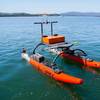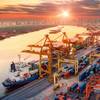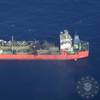Electronics: JRC Proposes Integrated Nautical Safety System
In the past decade more than 25,000 accidents have been caused by ships maneuvering under adverse environmental or traffic conditions. A leading cause of many of these accidents - by some estimates up to 70 or 80 percent - are due to "human error," confirmed by the fact that international organizations such as the International Maritime Organization (IMO) are dedicating significant time and resources to studying the problem and developing solutions.
The marine electronics community has used this trend to steadily build complete bridge systems which are increasingly integrated "plug and play" units. A high level of corporate consolidations has significantly aided this trend.
An example of complete integration is the Integrated Nautical Safety Systems - dubbed OceanExplorer II - from Japan Radio Co. OceanExplorer II is designed to reduce, by ergonomic improvement, the working environment such as the design of the workstation and the man/machine interfaces. It is, in principle, designed in accordance with DNV NAUT -AW and adopts their characteristics to support safer voyages.
The arrangement of the integrated workstations ensures that all instrumentation and controls necessary to perform tasks are within reach, easily accessible and immediately or easily readable, depending on their determined function. In particular, "within reach" should be allocated those instruments and controls that will be used most frequently. Any changes of the environment, including surrounding ships and sea conditions, can be easily recognized by ship personnel immediately on the bridge which is design decided ergonomically.
The JRC ECDIS JAN-901 ECR is designed to display radar video, electronic chart and nautical information. The electronic chart is able to display two different areas simultaneous in different chart scales to monitor ships progress or destination, and track review as Windows. The Track Control System with OceanExplorer II (ie. Automatic Navigation & Track Keeping systems [ANTS]) is designed to achieve reliable, economical and safe voyages, particularly in narrow channels, with ECDIS. The track accuracy is kept by high performance processing of real-time data from GPS, speed log, gyrocompass (rate of turn), rudder order/response, and controlling ships course and position to minimize difference from the planned route on the software of the ECDIS.
The chart radar is a harmonized system with ECDIS. All nautical information necessary is in one display, which effectively helps to reduce human errors. Also, this may help to minimize a number of displays on the bridge. The duplication of this multi-function radar also increases redundancy.






